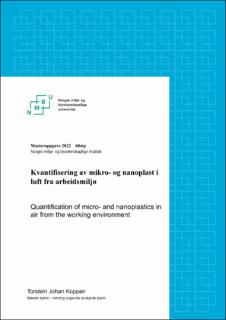| dc.contributor.advisor | Kallenborn, Roland Peter | |
| dc.contributor.advisor | Hammer, Stine Eriksen | |
| dc.contributor.advisor | Ervik, Torunn | |
| dc.contributor.author | Koppen, Torstein Johan | |
| dc.date.accessioned | 2023-01-11T09:36:50Z | |
| dc.date.available | 2023-01-11T09:36:50Z | |
| dc.date.issued | 2022 | |
| dc.identifier.uri | https://hdl.handle.net/11250/3042605 | |
| dc.description.abstract | Plast er i dag allestedsværende. I 2019 ble plastproduksjonen estimert til å ligge på 368 millioner metriske tonn. De siste årene har den toksikologiske nysgjerrigheten rundt de aller minste plastpartiklene, kategorisert som MP <5mm, og NP<1000nm blitt stadig økende. Det er per dags dato et stort kunnskapshull med tanke på å plassere den toksikologiske faren ovenfor mennesker. Et viktig delelement for å kunne vurdere trussel MP/NP har, er å evnen til å definere mengden, eller omfanget i omgivelsene. En av de fremtredende teknikkene på området er pyrolyse-gasskromatografi/massespektroskopi (pyro-GC/MS). Dette er en sensitiv og selektiv metode som definerer plastmengden basert på den totale massen som blir analysert. Ved å kombinere denne egenskapen med størrelsesdiskriminering før analysen, dannes en evne til å definere mengden innenfor ulike partikkelstørrelser i det utvalgte mediet.
I masterprosjektet ble det analysert filter som hadde samlet opp plast fra luft, i to ulike arbeidsmiljøer. På det ene stedet ble plastprodukter produsert, og på det andre foregikk avfallsbehandling av plast. Plastpartiklene ble størrelsesdiskriminert ved bruk av en kaskade impaktor. Avgrensningene skjedde innenfor rammene 10-2,5µm, 2,5-1,0µm, 1,0-0,5µm og 0,5-0,25µm. | en_US |
| dc.description.abstract | Plastic is now ubiquitous. In 2019, the plastic production was estimated at 368 million metric tonnes. In recent years, the toxicological curiosity about the smallest plastic particles have increased a lot. The smallest plastic particles are often categorized as microplastics (MP) <5mm, and nanoplastic (NP) <1000nm. There is currently a huge knowledge gap in terms of the toxicological threat to humans. An important sub-element for understanding the threat, is to be able to define the amount in the environment. One of the most prominent and promising techniques in the field is pyrolysis-gas chromatography-mass spectrometry (pyro-GC/MS). This technique is very sensitive and selective. The method defines the plastic content based on the total mas being analyzed. By combining this property, with some sort of size discrimination of the particles before the analysis, gives an opportunity to define the amount within bounded size ranges.
In the master’s project, plastic particles were collected from air samples at two quite different working environments. One of them waste-threated plastic, and the other one produced plastic product. The particles were size discriminated by using a cascade impactor, in the ranges of 10-2,5µm, 2,5-1,0µm, 1,0-0,5µm og 0,5-0,25µm. Within each step, there were a filter collecting the particular mas. | en_US |
| dc.language.iso | nob | en_US |
| dc.publisher | Norwegian University of Life Sciences, Ås | en_US |
| dc.rights | Attribution-NonCommercial-NoDerivatives 4.0 Internasjonal | * |
| dc.rights.uri | http://creativecommons.org/licenses/by-nc-nd/4.0/deed.no | * |
| dc.title | Kvantifisering av mikro- og nanoplast i luft fra arbeidsmiljø | en_US |
| dc.title.alternative | Quantification of micro- and nanoplastics in air from the working environment | en_US |
| dc.type | Master thesis | en_US |
| dc.description.localcode | M-KJEMI | en_US |

